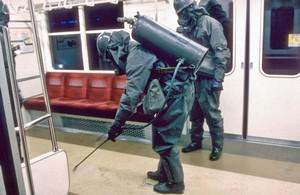AnthraxCleaning up subways after release of biological warfare agent such as anthrax
If you’re like most people, you don’t spend much time thinking about what would happen if anthrax was released into your local subway system. But Sandia Lab engineer Mark Tucker has spent much of the past twenty years thinking about incidents involving chemical or biological warfare agents, and the best ways to clean them up. Tucker’s current project focuses on cleaning up a subway system after the release of a biological warfare agent such as anthrax.

Cleanup following 1995 Tokyo subway sarin attack // Source: .wikispaces.com
If you’re like most people, you don’t spend much time thinking about what would happen if anthrax was released into your local subway system.
Luckily, Sandia National Laboratories engineer Mark Tucker has spent much of the past twenty years thinking about incidents involving chemical or biological warfare agents, and the best ways to clean them up. Tucker’s current project focuses on cleaning up a subway system after the release of a biological warfare agent such as anthrax.
Sandia Lab says that in addition to developing Sandia’s decontamination foam, which was used to decontaminate parts of federal office buildings and mailrooms during anthrax letter attacks in 2001, Tucker has led Sandia’s team during numerous chemical and biological remediation projects sponsored by the Department of Homeland Security Science and Technology Directorate’s Homeland Security Advanced Research Projects Agency.
These projects focused on specific remediation situations, starting with cleaning up an airport after a biological agent release. Teams of researchers tested available decontamination methods and technologies, learned what current technologies can’t do, researched solutions and then developed recommendations in case of an airport attack.
Their work progressed through a series of DHS projects to clean up an airport after a chemical release, steps to take in a citywide anthrax attack and how to scour a subway system after a chemical release.
A critical aspect of cleaning up chemical and biological warfare agents is figuring out what the contaminant is and how far it has spread. Sandia engineer Bob Knowlton has worked on this challenge for a dozen years. His team has developed scientific sampling methods to determine the extent and nature of the contamination. Sampling also is essential to confirm the decontamination was effective and the site is safe to re-enter.
Tucker said, “What we’re trying to do is make it so that if somebody does release anthrax into a subway system, we can get the system back into operation as soon as possible while still protecting public health and safety.”
